Phalaenopsis orchid: features and care at home
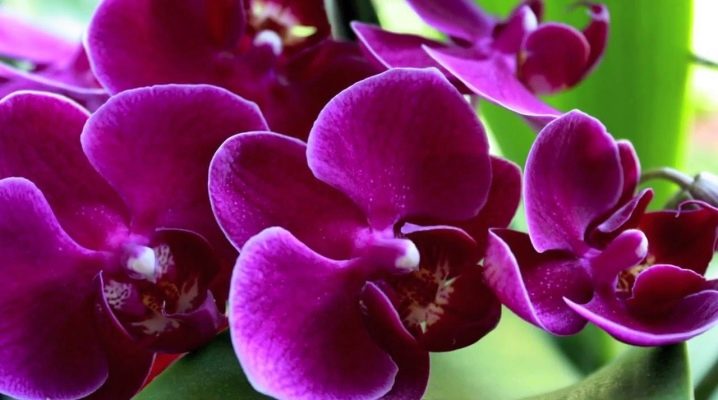
If you want to have a very beautiful exotic flower, then you should consider purchasing a spectacular Phalaenopsis orchid. Otherwise, this plant is called a butterfly flower. It is loved by many flower growers for its unique appearance, which is hard not to fall in love with. Today we will take a closer look at this unusual plant and learn how to care for it when kept at home.

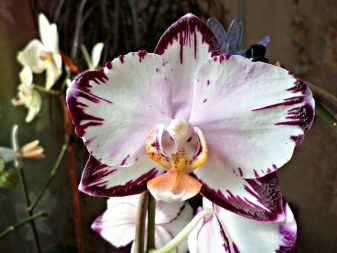
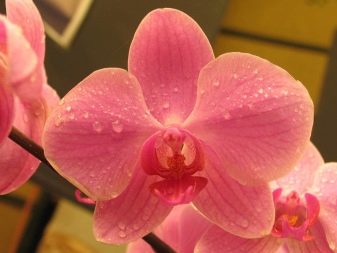
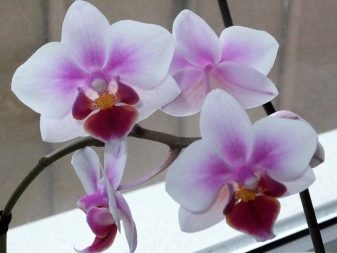
Description
There are a great many flowers of extraordinary beauty, but phalaenopsis is one of the most spectacular and amazing. It attracts a lot of attention due to its unique beauty. Such an orchid is an exotic flowering plant belonging to the Orchid family. This popular stunning flower is native to the rainforests of Indonesia, Australia, and Southeast Asia.
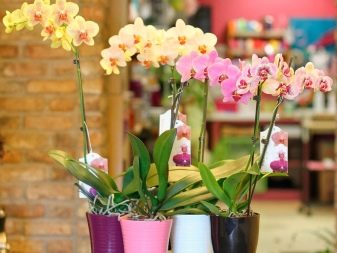

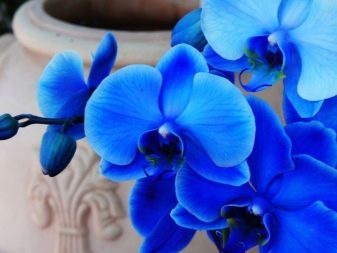
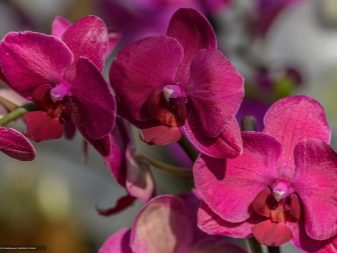
The growing point of this type of orchid is one - the root rosette of the leaves. In the course of growth, the described flower can reach up to 1 meter. Breeders have developed hybrid varieties of such an orchid. You can choose the option you like for every taste and color. For example, many people prefer miniature bushes that do not take up much free space, but look very original and bright. Of course, the selection of such orchids is not limited to just small specimens. You can also purchase luxurious giants with an interesting and original appearance.
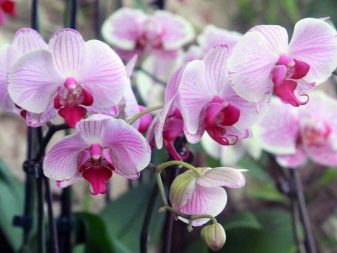
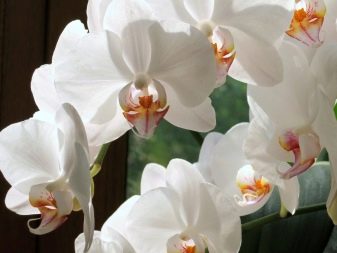
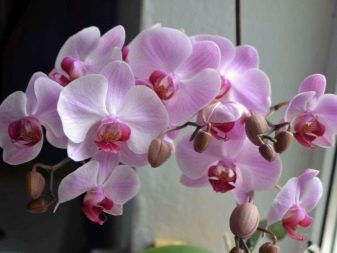
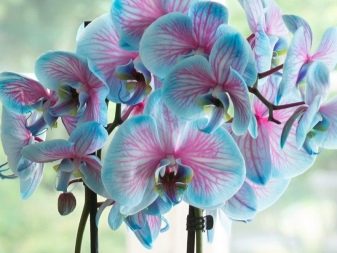
The most common are two main types of such colors:
- standard - it can reach a height of one meter;
- small - miniature butterfly flower reaches a height of no more than 30 cm.
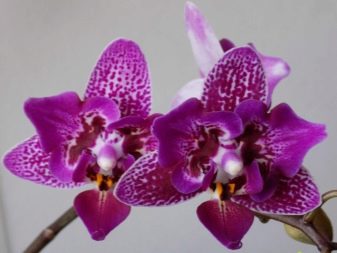
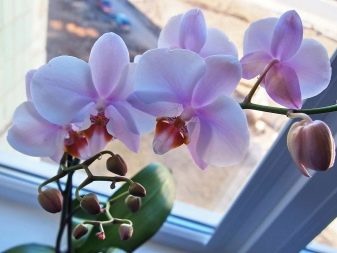
The phalaenopsis color scheme is also very variable. There are charming flowers, the color of which is close to pure white shades, and there are also almost black species that look very beautiful and unusual. Many people prefer bright yellows, lilacs, purples and purples that look great. In addition to pure tones, there are also interesting flowers, the petals of which have specks, stains, specks of different sizes and even a pattern that resembles hieroglyphs.
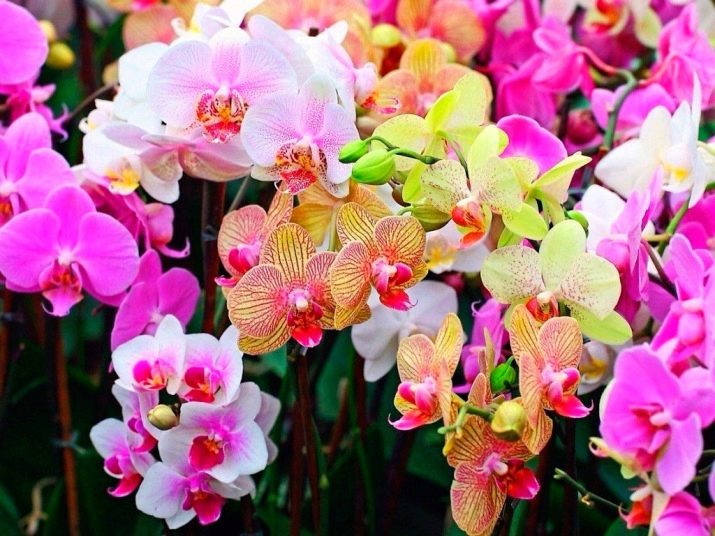
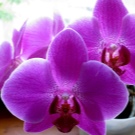
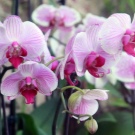



More recently, only experienced and professional growers have been involved in the cultivation of these beautiful flowers. Today, these types of orchids are quite possible to meet not only in spacious flower greenhouses, where you can easily provide them with ideal tropical conditions, but also in simple city apartments where lovers of exotic solutions live.
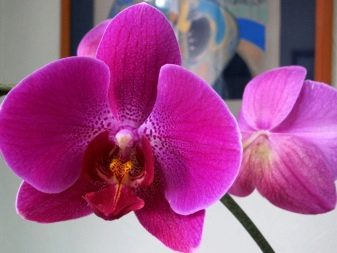
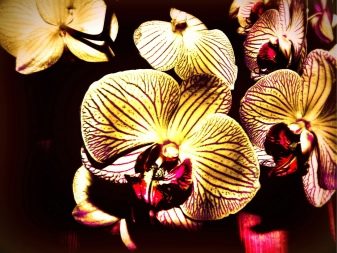
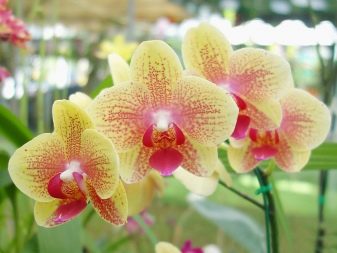
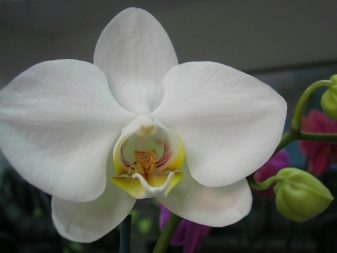
The flowering of such orchids can occur in any season. Flowering can last from 2 to 6 months. Of course, a lot here depends on the very state of the flowers, as well as the conditions in which they are contained. As a rule, phalaenopsis bloom 2 times a year. However, sometimes there is also a third flowering within one year.
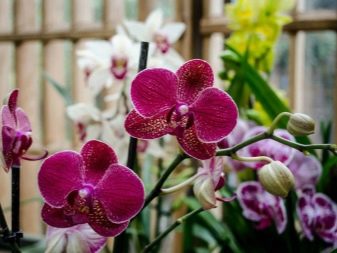
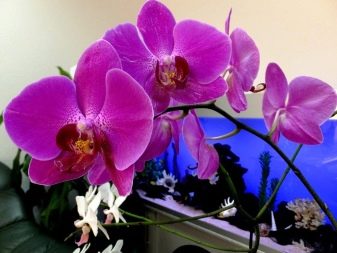
The size of flowers and peduncles usually ranges from 2 to 15 cm. Their number varies from 3 to 40 pieces.The immediate number of buds on the arrow directly depends on the branching of the peduncle itself. The conditions of keeping the butterfly orchid play an important role here.
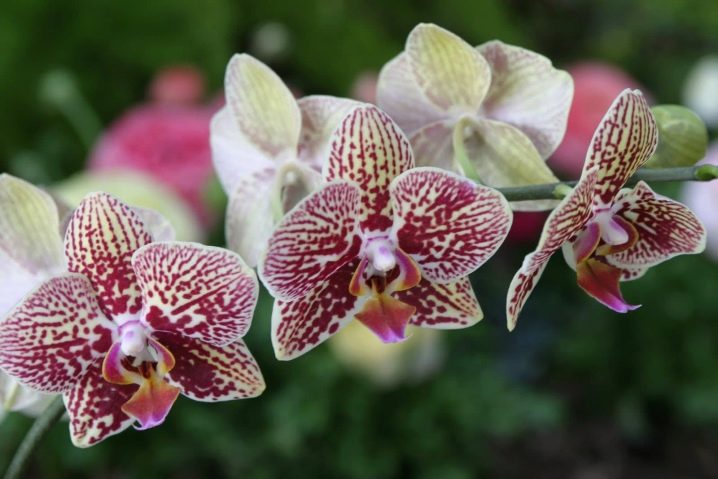
The very nature of this butterfly flower is epiphytic. For this reason, this orchid is simply not designed to extract nutrients from water or soil. The described plant can receive the liquid in only one correct way - from the air.
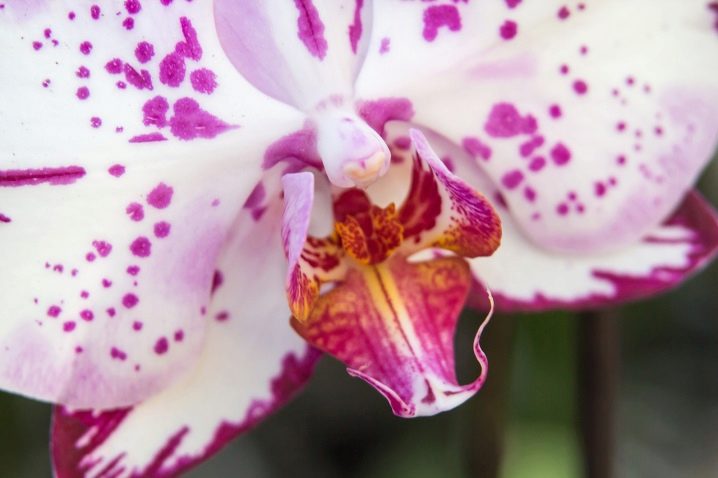
In a city apartment, these wonderful flowers live and bloom for many years absolutely without problems. Of course, subject to competent and responsible care.
It is worth noting that caring for butterfly flowers is not very simple. In this matter, it is very important to follow all the necessary rules and take care of the optimal conditions for the growth of flowers. Otherwise, the cultivation of such orchids will not be successful.
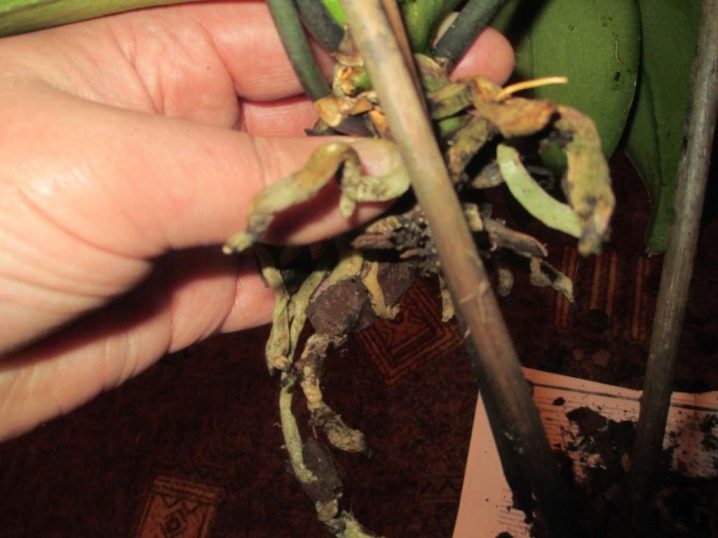
Climatic conditions
Phalaenopsis, like any other orchid varieties, prefers a fairly high humidity. This flower does not tolerate heat well. That is why it is so important to maintain in the room where such plants are located, the daytime temperature, which is kept at a level of 20-27 degrees. The night temperature should vary from 15 to 23 degrees. It is also very important to take care of the absence of unnecessary drafts. There should be no sudden changes in temperature values in the room, since this has a very bad effect on the development of a vulnerable indoor orchid.


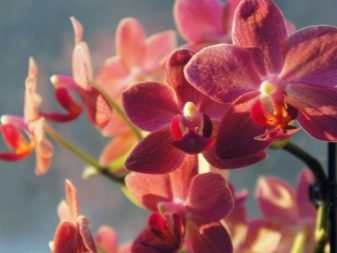
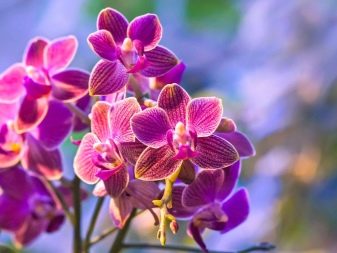
If we consider in more detail the information on spraying such plants, then here it should be noted that this can contribute to the development of infectious processes. It is also important to take into account the fact that water and moisture should never get on the orchid inflorescences. In order to maintain the necessary humid microclimate in the surrounding space, it is recommended to separate the window opening using a special screen, film or curtain. In addition, experts recommend doing the insulation of the radiator in the room where the phalaenopsis grow. To do this, a fairly wide board or other similar detail is often laid under the windowsill.


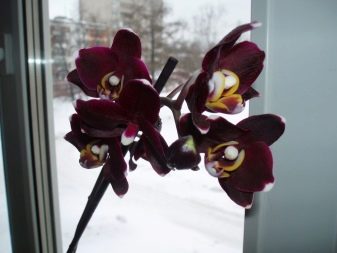
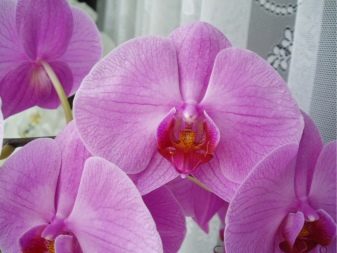
What color are
Phalaenopsis orchid has a large number of different subspecies. Only the main varieties reach 70 varieties. When it comes to bred hybrid specimens, the number of subspecies is simply enormous. All existing orchid hybrids cannot be collected in one suitable catalog, especially if you capture all the possible colors and shades that exist today.

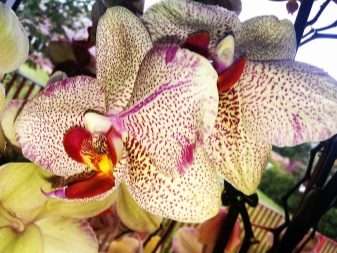
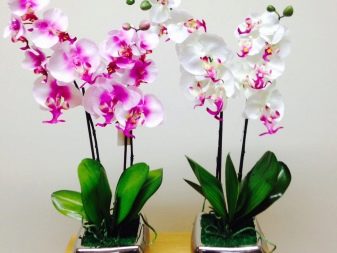
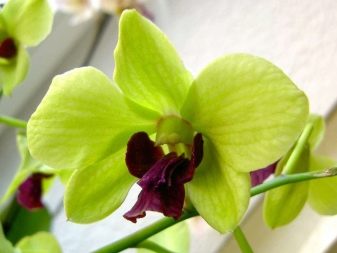
The most common are violet, purple, pale pink and light (close to white) colors. If you want to get closer to more original and expressive options, then it is better to turn to:
- blue;
- black;
- orange;
- spotted;
- red;
- green;
- blue;
- yellow;
- peach.
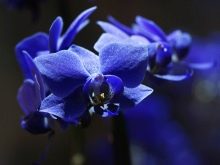
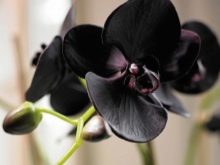
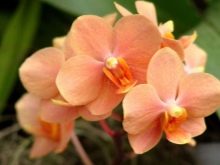
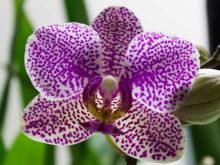

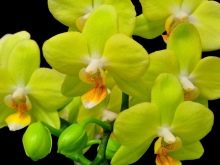
Butterfly flowers of original colors can decorate many environments. They attract a lot of attention to themselves. Moreover, these specimens are able to play the role of bright accents in the interior.

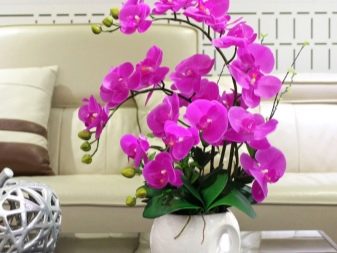
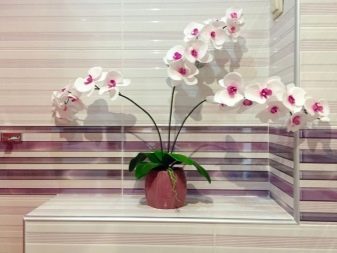

Landing
Planting phalaenopsis should be carried out according to all the rules. Only if everything is done correctly, you can count on the fact that the flower will grow beautiful and healthy and will not cause problems.
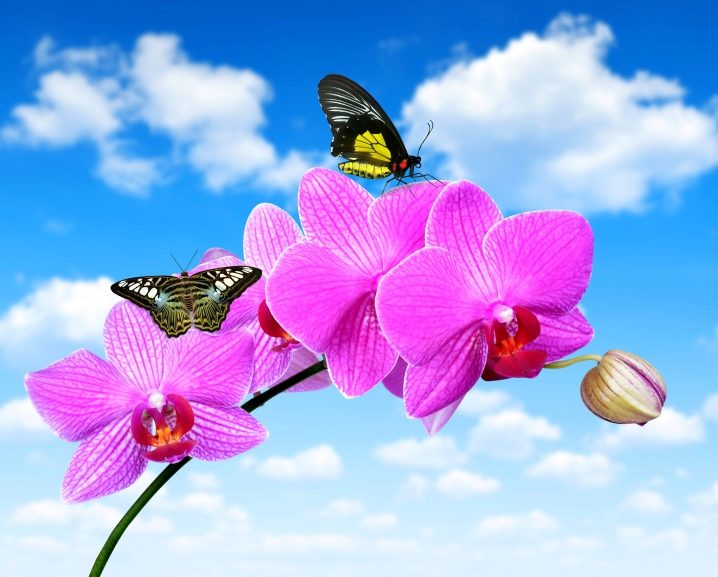
Pot selection
The first step is to choose the right pot in which the orchid will grow.
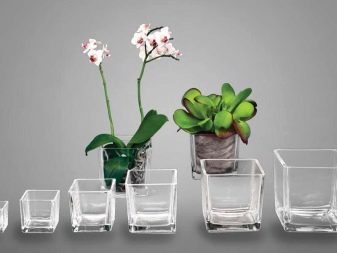
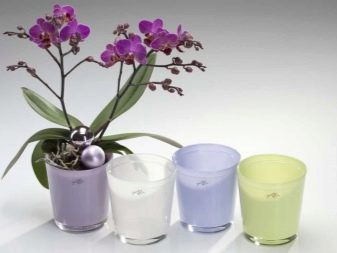
Epiphyte roots require a sufficient amount of natural light. That is why experts advise placing such plants in transparent flowerpots made of polymer materials. Often, orchids are placed in beautiful and graceful glass vases, which only emphasizes their showiness and brightness. However, if exposed to direct sunlight in glass containers, plants can seriously burn the roots.

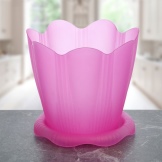
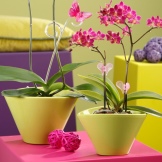
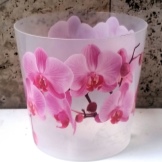
If we take into account the fact that the rhizome system of these plants develops in the direction not inward, but superficially horizontally, then the container must be selected wider and more spacious. It shouldn't be too deep. In order for the orchid to develop correctly and fully, it is necessary to provide it with proper air exchange. To do this, experts recommend turning to containers that have special holes at the bottom. To prevent the development of bacteria and fungi dangerous for plants, holes should also be made on the side of the walls of the container so that there is sufficient aeration. It is advisable to fill the flowerpot by 1/3 with drainage prepared from sea or river pebbles.
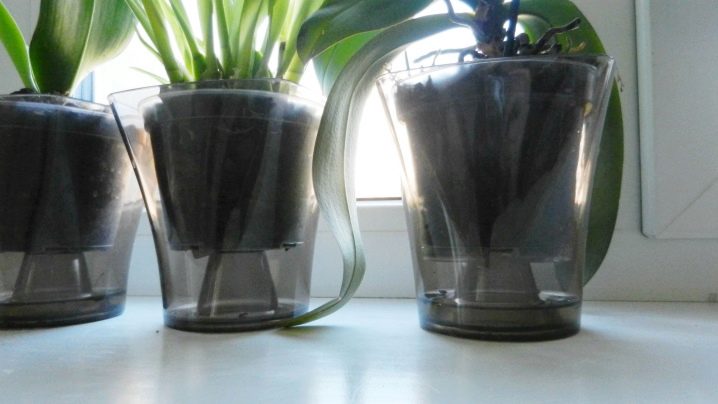
Substrate preparation
It is also important for planting to properly prepare the substrate. This is the composition with which the plastic pot is filled. He must necessarily meet the requirements of the orchid, as well as the immediate conditions of detention. If there is dry air in the room, then a more moisture-absorbing mixture should be used. It usually consists of the main components:
- pine bark, for example, spruce or pine;
- sphagnum moss;
- charcoal in a ratio of 5: 2: 1 (the dimensions of the substrate particles should not exceed 2 cm).
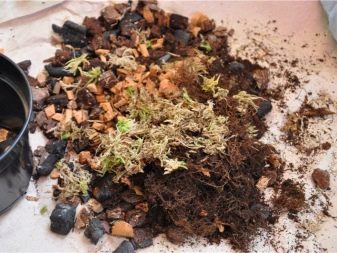
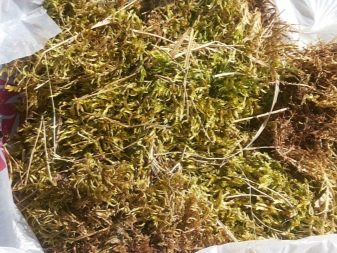

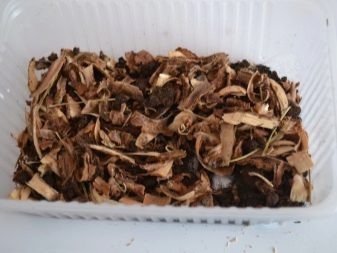
Using only the listed components, selected in various proportions, it will be possible to make a substrate that has a high or medium moisture capacity.
If you need to make a more moisture-absorbing substrate, take pine bark and peat in a 1: 1 ratio. If you want to prepare a soil of medium moisture capacity, then you should use the bark of needles and peat, but already in proportions of 7: 1. So that the substrate has good nutritional properties , shredded fern roots, quite a bit of high-moor peat, coconut fibers and chips should be added to the substrate. In the role of drainage, it is desirable to use exclusively natural ingredients, such as pebbles and gravel.
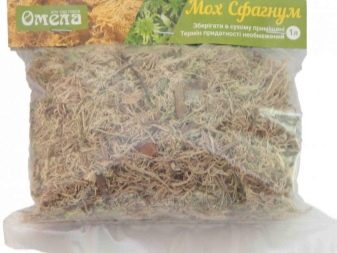
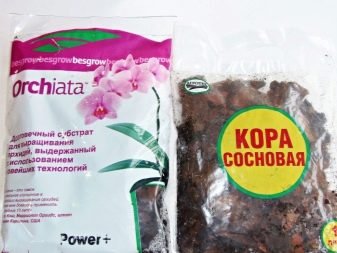
It is better not to use expanded clay from clay, because its high content of cavities, subject to low watering, will take away moisture from the flowers themselves, which, of course, will not benefit them.
For butterfly orchids, you can use another unusual substrate. To prepare it, you will need to collect pine bark. It is desirable that it be firm enough, but without resin. It will need to be crushed into separate pieces, the size of which is from 1 to 3 cm. You should also add pieces of charcoal of similar parameters, and with it particles of foam and wine corks. Despite the rather strange composition, such a substrate is ideal for phalaenopsis.
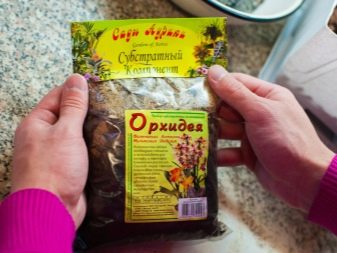
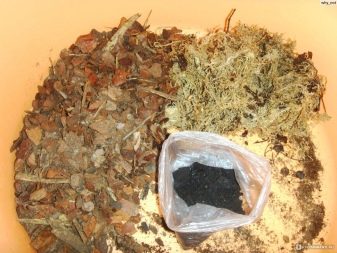
In specialized flower shops, it is quite possible to find a quality mixture that is ideal for planting home orchids. However, it is extremely important to remember that the substrate must pass the liquid through itself well enough, but retain the smallest amount of moisture, and also have good air permeability and antiseptic characteristics. For such purposes, experts advise using charcoal, but it should not be more than 5% in the substrate. Despite the many positive qualities of coal, over time it begins to accumulate salts in itself, which negatively affect the pH level of the substrate itself.

Instead of charcoal, it is permissible to add dried apple or peach leaves in a limited number to the soil. These elements will help prevent the formation of putrefactive microorganisms.
The state of the substrate for flowers selected or prepared by your own hands should be monitored. It is important to pay attention to the development of the root system, and also to keep the moisture level under control. As soon as you notice that there are the first signs of destruction of certain areas of the mixture, then the decomposed soil will need to be replaced as soon as possible. This can be done either partially or completely.
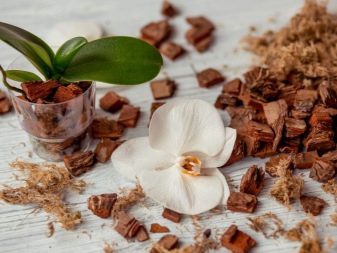
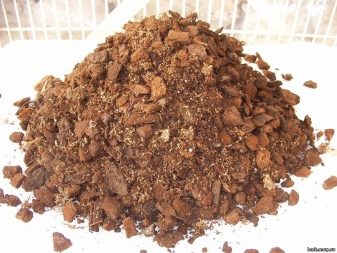
Before planting an orchid in prepared soil, it is necessary to prepare all the necessary items. It is necessary to thoroughly process the selected pot with a 2% soda solution, and then rinse it and pour over boiling water (at least 70 degrees). Next, you should mix the composition for the substrate in the required proportions. Then you need to prepare a sufficiently sharpened knife or blade so that you can easily cut off the damaged sections of the plant. We must not forget about the preparation of coal powder, which will be used to process the cut areas.

It is not at all difficult to plant an orchid in a dedicated container on your own. But one should take into account the fact that the subsequent transplantation of epiphytic plants differs in many respects from the planting of shoots with a taproot system.
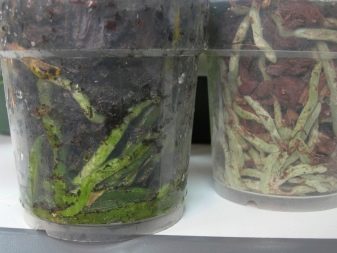
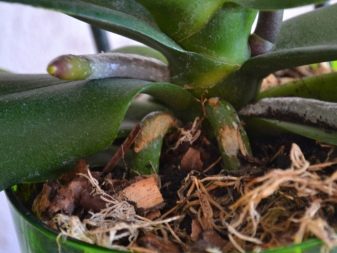
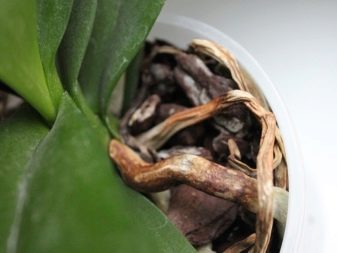
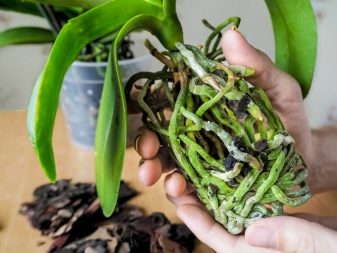
How to land by children
There are many ways to plant orchids. One of the most popular options is planting the babies of this flower. Before proceeding to direct disembarkation, all instruments should be thoroughly disinfected. To do this, you can turn to rubbing them with alcohol. It is advisable to pre-fill the substrate with a slightly pinkish solution of potassium permanganate. The baby should be cut using a sharp pruning shear. In this case, part of the peduncle will need to be left and let it lie down for about 30 minutes.
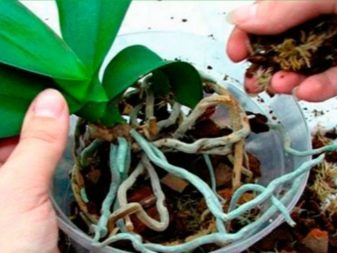
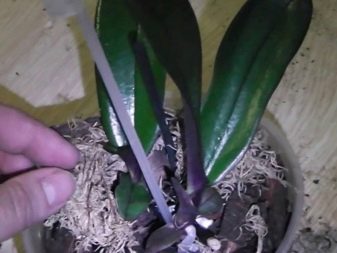
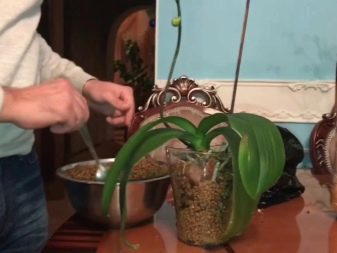

Sections on the "mother" plant, as well as on the shoot will need to be carefully sprinkled with ground cinnamon or crushed coal. The options for preparing the substrate are described above.
In order to plant an orchid baby at home, you must prepare a suitable container in advance. For example, if you are using a simple plastic cup, you will need to make a few holes in it. Then the prepared substrate is sent to this small vessel. The young plant is placed in the center of the prepared base so that the neck is flush with the edge of the glass itself. The roots should be evenly distributed over the selected plastic container, and a little more substrate should be added on top.
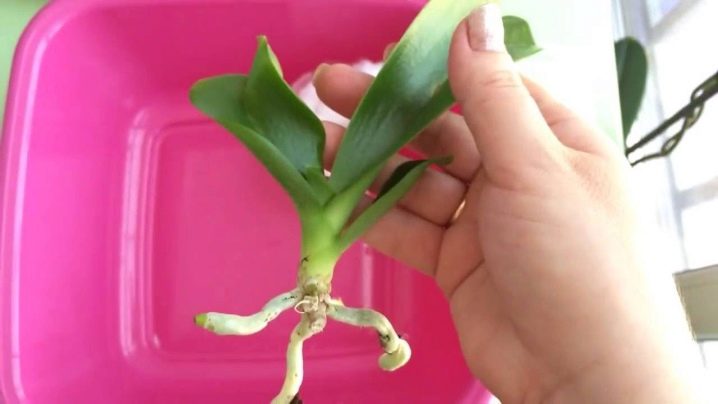
You do not need to crumple the soil by hand, because in the process of such actions, you can accidentally damage the root system, which, of course, will seriously harm the flower itself. You can just gently knock on the edges of the vessel - then the soil will settle without unnecessary help. In no case should you water the orchid immediately after watering. This also applies to feeding the plant. The first watering is permissible only after 2-3 days. During this period, all wounds on the trunk and roots will dry out and tighten. Thanks to this, the possible risk of their early decay and penetration of infections will be minimized.
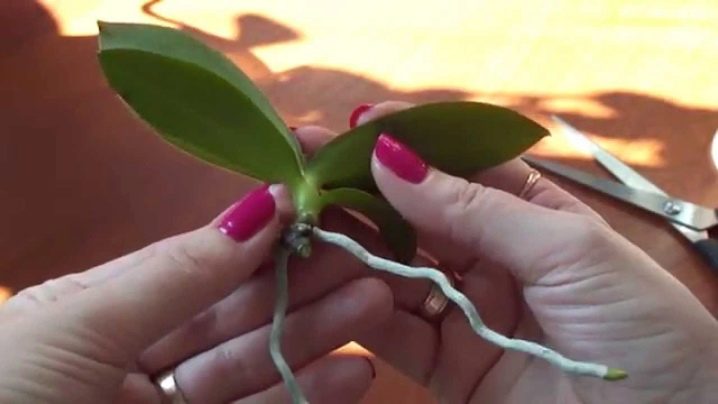
Care
Caring for butterfly orchids at home should be done according to all the rules. As in the case of planting these plants, you need to act competently and carefully. You cannot neglect any of the necessary care points, otherwise the plant will get sick and will not grow as it should. According to many growers, it is not so easy to care for phalaenopsis. Let's consider in detail what kind of care you need to provide for this beautiful but demanding flower.
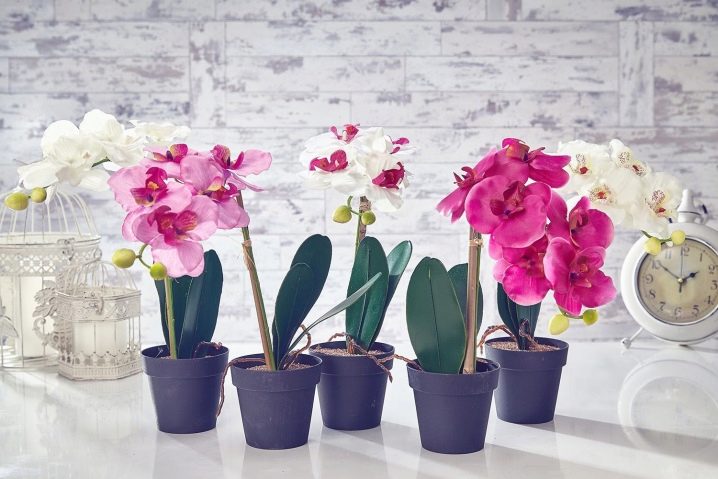
What to do with a new plant immediately after purchase
As soon as you bring the beautiful Phalaenopsis orchid you just bought from the store, it needs to be properly cared for right away. Let's consider step by step what you need to do with a freshly acquired flower.
- The first step is to correctly transplant the purchased flower, because in the inside of the pot, the manufacturer often lays out a kind of "pillow" made of pressed moss or peat. This affects the excessive waterlogging of the roots, because of which they can quickly begin to rot.
- Also, in the conditions of home care for such a flower, you must immediately choose a suitable place for it. It should be borne in mind that all phalaenopsis dislike constant movement from one place to another.Finding yourself in new conditions is already a serious stress for these beautiful and demanding flowers. Place the transplanted plant in a sufficiently lighted and warm place. You do not have to constantly turn the orchid pot if it is not necessary.
- Only if proper care is provided can we talk about the stress resistance of the orchid. To do this, you should use high-quality and suitable feeding. Some of them will be described below.
- A newly purchased and transplanted flower does not need to immediately rush to water. For the first time, it is recommended to do this by the method of a kind of straining along the very edge of the pot. Remove any remaining water from the planter immediately.
- Top dressing can be done only a month after transplanting.
- If you already have a number of planted orchids, then new acquisitions should not be immediately planted with them. First, fresh flowers must be quarantined, because they can be infected with all sorts of dangerous infections that can harm other plants. Watch the first month for a newly purchased new flower. Only after that it is permissible to transplant it to the rest of the butterfly orchids.
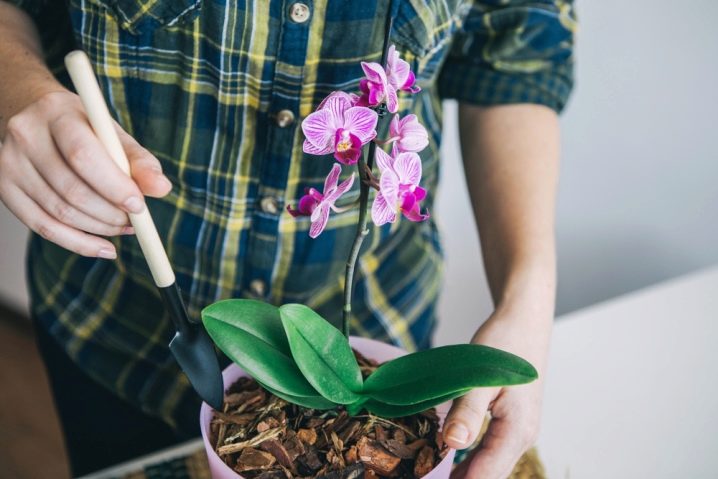
Watering
It is imperative for an orchid of any kind to ensure proper watering - this is one of the most important conditions for the correct and rapid growth of a flower. The best indicator that the flower has enough moisture, or, conversely, not enough, is the direct color of the roots. Let us consider in detail, as evidenced by the different color of these important components of the phalaenopsis orchid.
- If the roots have a characteristic green or light green tint, then this indicates that the flower does not need watering.
- If the color of the roots gradually changes from green to light gray, then this means that the plant needs watering.
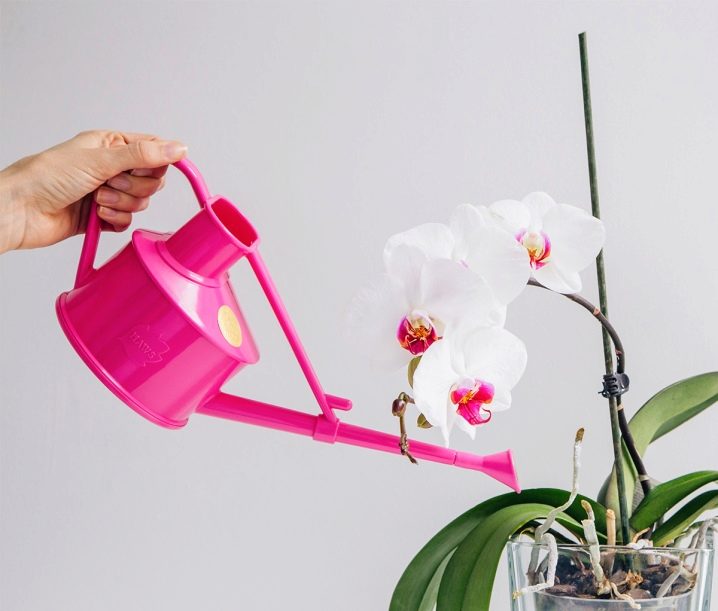
Watering this capricious plant, you do not need to be very limited in the given water. Pour in as much liquid as possible to restore a healthy green or light green color to the roots. In addition, the time for watering should usually come when the substrate dries up, and the pot with the plant itself becomes noticeably lighter. The dryness of the butterfly flower can also be evidenced by the noticeable lethargy of the leaves - these features must be monitored.
Florists strongly recommend keeping under control not only the amount of watering of the flower, but also the temperature regime of the injected water. In no case should it be too cold or hot. Water must be gentle at room temperature. In this case, watering will not harm the plant.

It is also very important to monitor the level of water hardness with which the orchid is watered. It is advisable to use only boiled rainwater. Such compositions will have a beneficial effect on the condition of the roots and the entire plant as a whole.
At first, such a number of conditions that must be observed when watering phalaenopsis can scare a novice grower. But there is nothing to be afraid of. Over time, carrying out all the necessary procedures will become a habit and will not cause the slightest difficulty. More experienced flower growers can easily cope with watering capricious orchids.

Pruning
It is not enough to provide this type of orchid with proper watering. This flower also needs correct pruning. If you notice that the phalaenopsis has already faded, then you should watch for some time how the old arrow behaves. If it begins to turn yellow and wither, then it will need to be removed without the slightest doubt and regret. If it still remains green and juicy, then, perhaps, after a two-month "respite", flower buds will appear on it again.
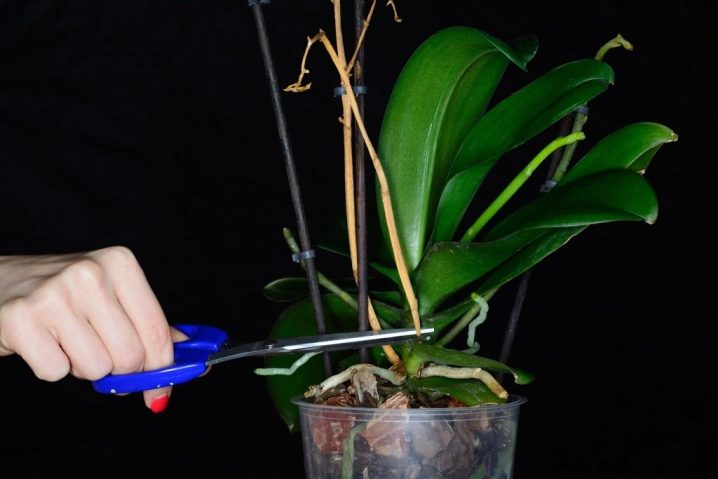
As for the new arrow, she needs to be given time to grow up. Only after that the buds themselves will be laid, which will subsequently give flowers.
If you notice that the old arrow turned out to be too long, then it will need to be carefully shortened. To do this, this element is cut off a little higher than the already developed bud by about 1 cm. Note that the lower the peduncle is cut, the more flowers will appear on the arrow on the side. One way or another, there is no need to cut the peduncle below the third bud - on the shortened arrow, you will have to wait too long for the next flowering.

Fertilizer
Like any other living plant, the butterfly orchid needs the right fertilization. Reproduction of this flower directly depends on a suitable and competent feeding. If you need to achieve a sufficiently lush flowering and further reproduction of the peduncle, then special preparations are used for this.
It is necessary to take into account a number of basic rules regarding the competent feeding of phalaenopsis. Let's get acquainted with them.
- Only healthy flowers can be fertilized. They must have a healthy rhizome system. The turgor of the leaves should also be good.
- It is not recommended to fertilize such flowers during the flowering period. This is due to the fact that this procedure speeds up the metabolism, due to which the duration of flowering can also be noticeably reduced.
- At rest, fertilization should be done once every two weeks or in accordance with the instructions for the applied preparation. If we are talking about a period of growth, then feeding will be needed once a week or in the amount specified in the instructions for the drug.
- After transplanting a flower, you should not start fertilizing immediately. On young and still immature flowers, this can be done only after a month.
- Always read the instructions for the selected top dressing before using it.

For feeding butterfly orchids, it is permissible to use different means. Let's consider some of the most popular ones.
- "Dr. Foley". This popular and effective product contains such important components as nitrogen and potassium. These components have a positive effect on tissue growth, as well as the development of flowers in general.
- Forte complexes. The composition of these funds contains phosphorus. It is responsible for the lush and long-lasting flowering of orchids.
- "Mr. Color." These are special biological fertilizers specially designed for orchids. The specified drug makes it possible to grow leaves, and with them rhizomes. In addition, this tool promotes the rapid development of peduncles.
- Succinic acid. This is a wonderful remedy that is an effective stimulant for the development of phalaenopsis. With such a top dressing, the flower grows much faster. Succinic acid is not able to completely replace a good fertilizer, but it will facilitate their easier assimilation, therefore, experienced flower growers advise not to neglect the use of this useful agent.
- "Zircon". This is a top dressing with a wide spectrum of action. It is often used to solve problems with seedlings of annual and perennial plants. Rooting of orchids is made easier by using this remedy. In addition, "Zircon" increases the stress resistance of these capricious flowers, restores immunity in case of damage by parasites.
A large flower with dense and heavy leaves must be carefully and securely tied to the supporting part and strengthened in such a way that it does not swing from side to side.
If the plant's root system has undergone serious and significant damage, then it will be quite difficult for it to recover. To rectify the situation, the flower will have to help a little. It will need to be put together with the pot in a plastic bag for just a couple of weeks, so that the diseased plant will be in conditions close to those of a greenhouse. Periodically, the orchid will need to be ventilated. The peduncle will need to be cut off in advance and moved to a vase filled with settled water. It is easier to sacrifice a flower stalk than to lose the whole flower.
Transplanting phalaenopsis into a new pot is also necessary for other good reasons.
- When the planting container turns out to be too tight and shallow, then the plant must be transplanted into a new pot. You can notice such problems by looking at the roots. They will either stick out above the pot, or they will fill all of its space inside and displace the substrate. Noticing such changes, the flower will need to be transplanted into a more spacious pot so that everything can fit in it - both the roots and the required volume of the substrate. Experts advise doing a transplant only after the flowering process.
- If, during transportation / movement, all the leaves fell to one side, and the peduncle itself, along with the supporting part, bent over, then a transplant is simply necessary. This process cannot be neglected even if the roots protrude out too much. You will need to transplant an orchid into a suitable pot with high-quality support. The voids should be filled with a good substrate.

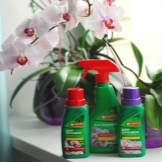


Transfer
If you want this beautiful flower to grow without problems and be healthy, it needs to provide a competent and timely transplant. Phalaenopsis bushes are transplanted no more than once every 2-3 years. This should be done at the moment when the substrate becomes dust. However, there are different reasons to transplant this plant urgently, without waiting for the right moment. For example, if during the quarantine period you noticed that the leaves began to fade and hang on the flower, and the soil, drying out, began to resemble an old washcloth, then you can do an urgent transplant - you should not pull here.
It is also necessary to start an urgent plant transplant if you notice dark spots on the roots or any traces that look like putrefactive formations. In such cases, the orchid will need to be carefully and quickly transplanted into a new pot, which will have to contain a different substrate. Moreover, one should not wait for the end of flowering here.

The plant will need to be removed as carefully as possible from the planting container. After that, you will also need to carefully and thoroughly rinse its roots. It is advisable to do this under a warm shower. If the soil is not washed off too easily and simply, then you need to move the flower for a while into a small basin filled with water. Next, you should free the roots from the soil, and also shake off the water. Thoroughly cut off rotten areas of plants, as well as too long and overgrown roots. The cut areas will need to be sprinkled with crushed activated charcoal or charcoal.
The next step is to leave the plant for a while, for example, overnight, in a dry and clean basin. This should be done so that all cuts are sufficiently tightened and dry. With the onset of the morning, the plants will need to be planted in a brand new, but always pre-disinfected pot. The soil mixture in it should be ideal for epiphytic flower plantings.
On the bottom of the selected pot, lay out a layer consisting of fairly large parts of the substrate. Small pieces of the same substrate will need to cover the voids in the space between the roots to the base of the sockets. At the top of the pot, you will need to leave a couple of free centimeters. They will come in handy so that as the aerial roots grow, there is as much free space as possible for adding the substrate.
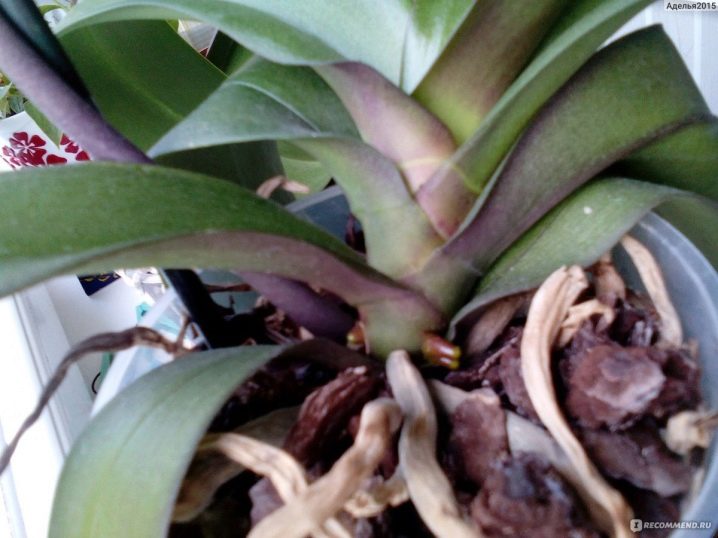
A large flower with dense and heavy leaves must be carefully and securely tied to the supporting part and strengthened in such a way that it does not swing from side to side.
If the plant's root system has undergone serious and significant damage, then it will be quite difficult for it to recover. To rectify the situation, the flower will have to help a little. It will need to be put together with the pot in a plastic bag for just a couple of weeks, so that the diseased plant will be in conditions close to those of a greenhouse. Periodically, the orchid will need to be ventilated. The peduncle will need to be cut off in advance and moved to a vase filled with settled water.It is easier to sacrifice a flower stalk than to lose the whole flower.
Transplanting phalaenopsis into a new pot is also necessary for other good reasons.
- When the planting container turns out to be too tight and shallow, then the plant must be transplanted into a new pot. You can notice such problems by looking at the roots. They will either stick out above the pot, or they will fill all of its space inside and displace the substrate. Noticing such changes, the flower will need to be transplanted into a more spacious pot so that everything can fit in it - both the roots and the required volume of the substrate. Experts advise doing a transplant only after the flowering process.
- If, during transportation / movement, all the leaves fell to one side, and the peduncle itself, along with the supporting part, bent over, then a transplant is simply necessary. This process cannot be neglected even if the roots protrude out too much. You will need to transplant an orchid into a suitable pot with high-quality support. The voids should be filled with a good substrate.
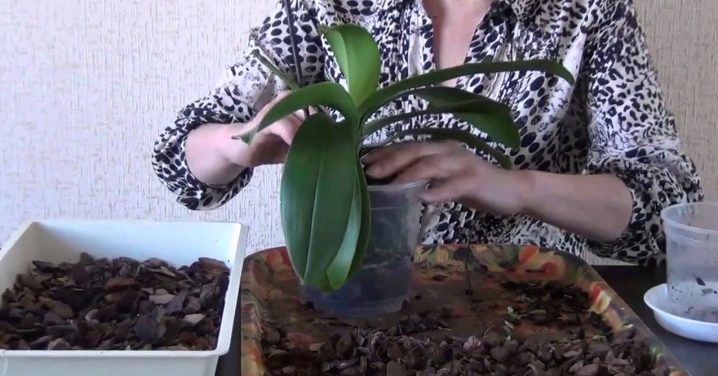
Diseases and pests
Like any other plant, phalaenopsis is susceptible to various diseases. Also, this flower can become a target for dangerous pests. Such an orchid can get sick with both infectious and non-infectious ailments. At the same time, it is very important to take into account the fact that a flower can fall ill only if it has not been provided with proper care. Consider what diseases this beautiful plant most often encounters.

Fusarium
Most often, orchids suffer from this serious fungal disease. In the first stages, the root system of the flower is affected, after which the disease begins to "move" to the entire plant as a whole. In most cases, this ailment appears if there is an excess of moisture. It will not be possible to cure a sick bush. You just need to burn it.
Some of the other types of rot can still be cured. Such diseases include anthracnose, rust, or spotting. In some cases, spraying the plant with a fungicidal preparation allows you to get rid of such problems.

Hives
Orchids often suffer from this common disease. In a diseased flower, leaf lesions are noticeable. At first, they manifest themselves as large specks, which can reach from 20 to 30 mm in size. The development of this disease is also facilitated by a too high level of humidity, an unnecessarily low air temperature, as well as poor-quality ventilation of the room. If you start to properly care for the phalaenopsis in time, he will soon recover.
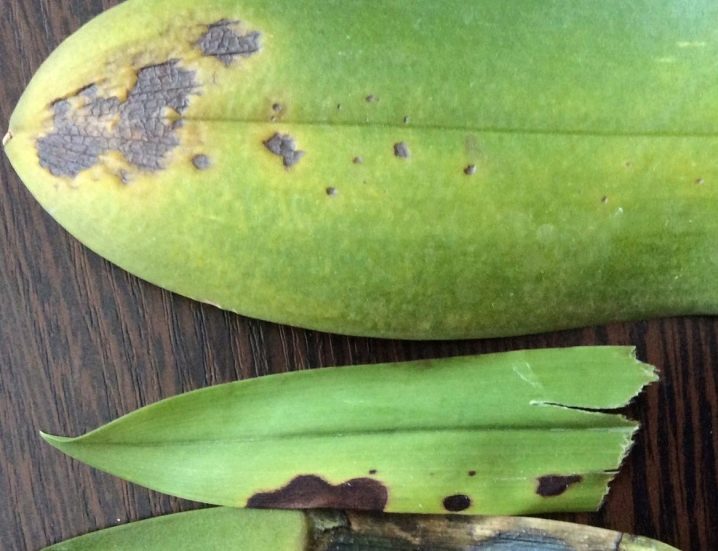
Botrytis
Orchids most often suffer from this disease due to excessive humidity in the air, as well as insufficient ventilation in the room where they are located. In the early stages of the disease, dark brown spots appear on the petals. Then the petals fade altogether. If the air temperature is raised in the room, the disease will develop a little more slowly. In addition, you will need to ensure that there is good ventilation. The bush itself should be carefully treated with a good bactericidal agent.
Such types of orchids also suffer from various pests and parasites. It is imperative to fight with them, otherwise destruction and negative modification of the shoots may take place, as a result of which the flowers will simply die. Let us consider in more detail which pests most often choose phalaenopsis as their target.
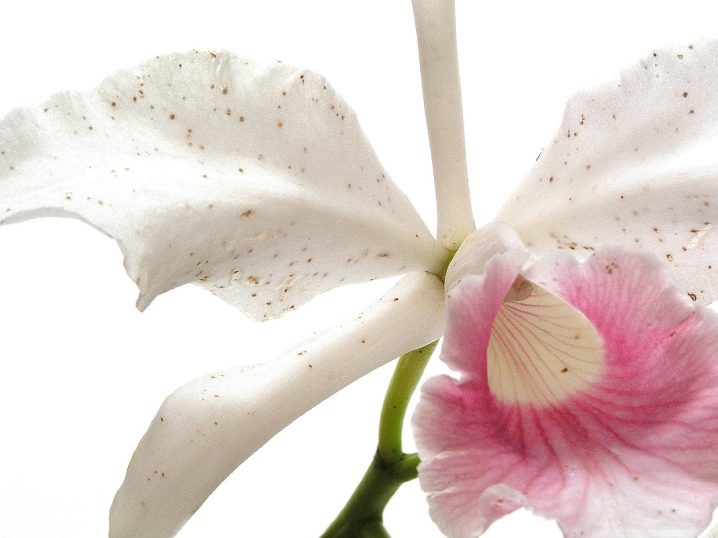
Mealybug
If a pest such as a mealybug is present on a flower, then because of this, the foliage soon begins to noticeably turn yellow, and then completely fly around. In order to get rid of this parasite dangerous for plants, leaves and shoots must be treated with a high-quality solution prepared from laundry soap.
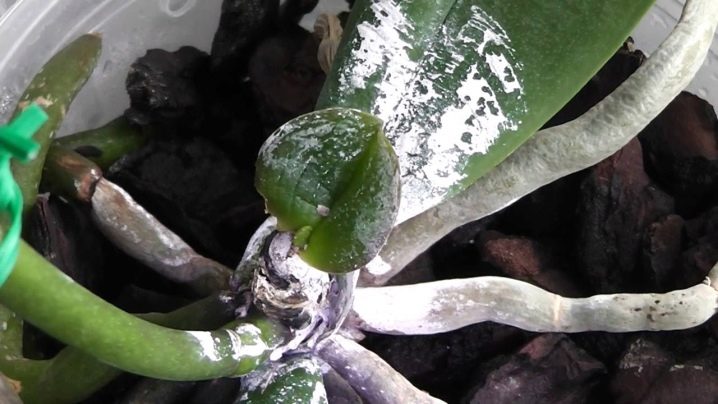
Spider mite
This pest appears on orchids only if the air humidity in the room where the plant is located is too low.It is possible to determine that a spider mite has wound up on a bush by the presence of a noticeable silvery cobweb on the leaves. The latter looks like it was pricked with a thin needle.
If there is not very much of this pest on the flower, then it will be possible to get rid of it by treating it with a simple soap solution. With the same tool, you can easily remove worms and aphids from the orchid. If there are too many spider mites on the flower, then it will not be possible to do without the use of a special acaricidal agent.
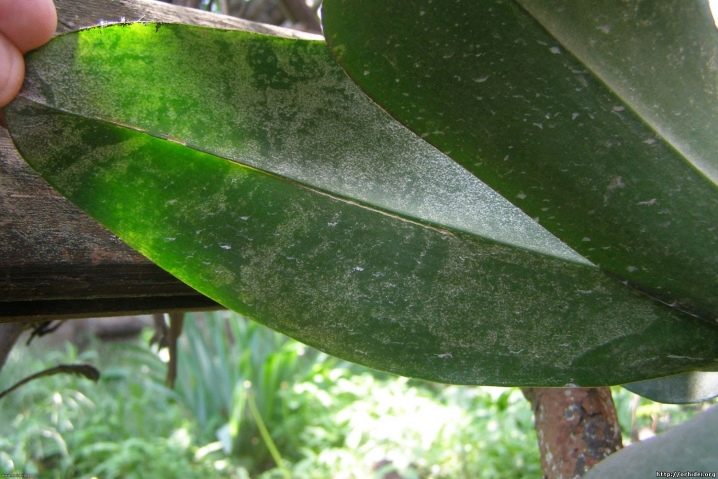
Thrips
Thrips are another common pest that butterfly orchids can fall prey to. These parasites can cause serious harm to the flowers and leaf blades themselves. In this case, brown spots appear on the surface of the latter. To rid the plant of these dangerous pests, you will have to turn to serious treatment with a systemic insecticide, for example, "Isatrin" or "Aktellik". However, experts recommend using Fitoverm for this purpose, which is characterized by an insignificant level of toxicity.
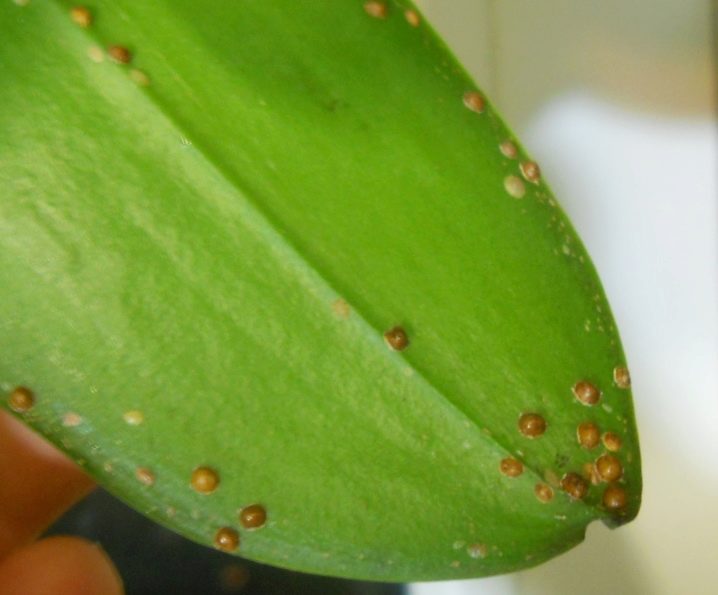
Shields
The origin of bumps on orchid leaves may be associated with these dangerous pests. The scale insects simply suck out all the juice from the flower, which is why it soon inevitably begins to wither. It will be possible to neutralize this parasite in the same way as from the worm described above. For this purpose, the flower will need to be treated with soapy water twice, taking a break of 7 days.
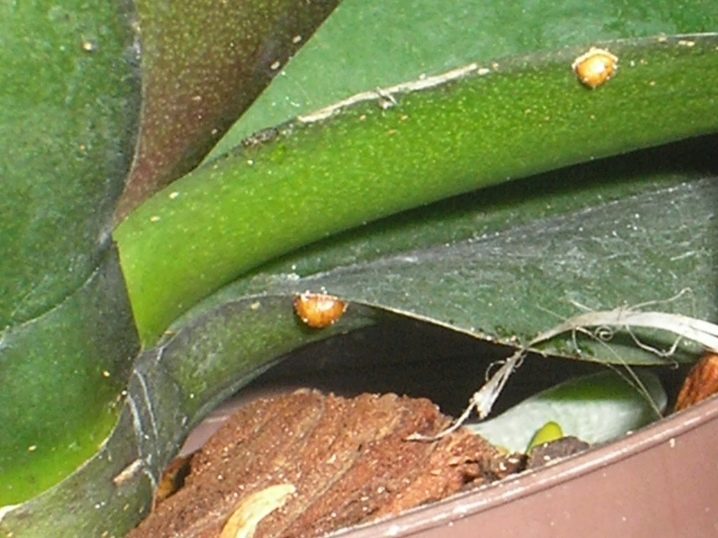
Slugs
The greatest harm to orchids can be caused by slugs. Since these pests are impressive in size, they can be noticed almost immediately. In the shortest possible time, slugs are able to chew on shoots, and with them foliage and flowers. In order to catch these parasites, a cucumber or carrot, cut into pieces, is spread over the surface of the substrate. After that, it will be necessary to wait until the slugs appear from their hiding places. So they can be quickly and easily removed from the plant.
If you cannot get rid of these pests using various baits, then it is permissible to turn to the treatment of the bush with an insecticidal preparation. For example, it can be effective "Mesurol" or "Metaldehyde".
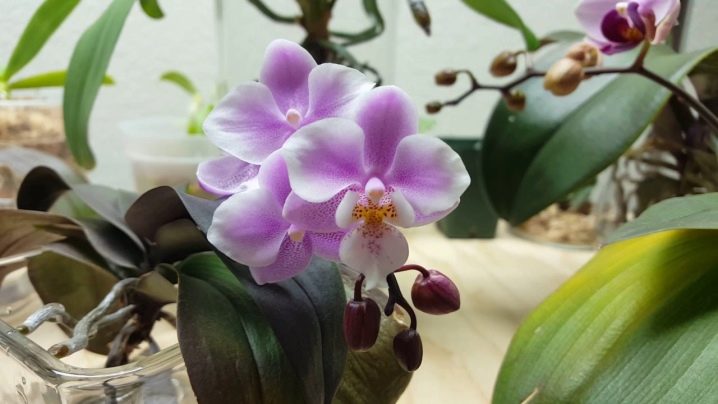
Helpful hints and tips
If you have decided to buy and plant luxurious phalaenopsis orchids, then you should be armed with a number of useful tips and recommendations from experienced florists, because in the care and handling of this flower, it demonstrates itself as quite capricious and demanding.
- When choosing a place for this chic color, it is recommended to give preference to an oriental window. It is permissible to adhere to a western or northeastern orientation. If you plan to put the plant on a windowsill located on the south side of the room, then it is better to put it on a small table located next to the window closed with a curtain.
- During the rest period, when flower buds are laid, the temperature at night for orchids should be at least 4-5 degrees compared to daytime readings.
- In order for the orchid to bloom for a long time, you should not move the pot with it from one place to another. In addition, the room must be kept at the same optimum temperature.
- The category of viral diseases includes ailments such as spotting or mosaic. Unfortunately, these diseases are incurable. If a flower suffers from such a misfortune, then nothing will be able to help it - it will need to be burned so that the infection does not spread to other plants, if any. It must be remembered that such viruses are carried by insects, so the spread of the disease cannot be avoided.
- Never place the phalaenopsis pot in a place where it will be exposed to direct sunlight. The latter must necessarily be neutralized, for example, with a closed curtain.If you do not adhere to this rule, then you will not have to wait for a good flowering of the plant.
- It is recommended to buy such a beautiful plant during its flowering period. In this case, you will be able to choose exactly the color that you like most or that is missing in your already collected collection of flowers.
- Pay attention to the phalaenopsis roots. In a healthy plant, they will definitely be green and powerful enough. If you gently move a healthy flower in a pot, they will continue to be tightly held in the substrate. If the rhizomes of orchids are sick with something, then they will be noticeably lethargic and mobile.
- The plant must be properly prepared for planting. This step cannot be neglected. Together with the substrate, the flower is carefully removed from the flowerpot. It will be much more convenient to divide it into several parts. After that, the orchid will need to be very thoroughly rinsed in settled water. The temperature of the latter should not be higher or lower than room temperature.
- Experienced growers recommend using a small watering can to water the potted orchids evenly. Watering the plants should be stopped as soon as moisture begins to flow through the existing drainage holes. After that, the remaining liquid must always be drained from the stand and watering repeated after a few minutes.
- At the stage of inflorescence formation, it is recommended to increase the watering of the plants. As soon as the flowers open, it is advisable to raise the night temperature by about 5 degrees.
- We must not forget about cutting the peduncles. This must be done so that they do not interfere with the development of new ones.
- Be attentive to the condition of the substrate, especially if it is purchased. It is very important to keep its moisture level under control, because due to its high values, orchids can become seriously ill (including incurable diseases).
- When applying store dressings and fertilizers, you must read the instructions. Even if you are confident in your skills and consider yourself an experienced florist, you should not neglect this stage.
- When transplanting and generally caring for phalaenopsis, it is very important to act as carefully and carefully as possible. Do everything slowly so as not to harm the plant.
- Having noticed the first signs of any disease on a flower, you do not need to waste time. You should start treating the orchid as soon as possible. If the disease is incurable, then you need to get rid of the flower quickly, especially if there are other plants in the neighborhood.
In the video below, useful tips for caring for Phalaenopsis orchids.



























The comment was sent successfully.